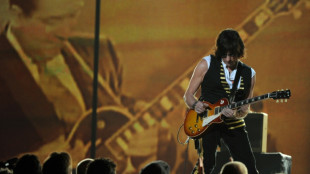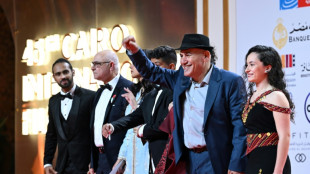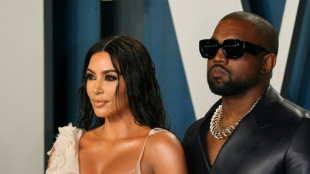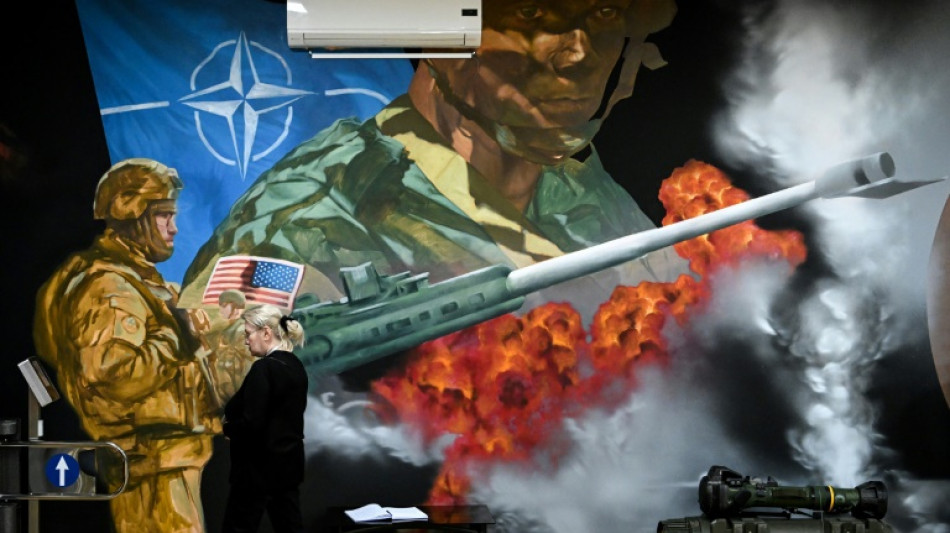
-
 Dutch coalition survives political turmoil after minister's resignation
Dutch coalition survives political turmoil after minister's resignation
-
Uruguay end winless run with dramatic late win over Colombia

-
 Max potential: 10 years since a teenage Verstappen wowed in Macau
Max potential: 10 years since a teenage Verstappen wowed in Macau
-
Tens of thousands flee as Typhoon Man-yi nears Philippines

-
 Is Argentina's Milei on brink of leaving Paris climate accord?
Is Argentina's Milei on brink of leaving Paris climate accord?
-
Big Bang: Trump and Musk could redefine US space strategy

-
 Revolution over but more protests than ever in Bangladesh
Revolution over but more protests than ever in Bangladesh
-
Minister resigns but Dutch coalition remains in place

-
 Ireland won 'ugly', says relieved Farrell
Ireland won 'ugly', says relieved Farrell
-
Stirring 'haka' dance disrupts New Zealand's parliament

-
 England's Hull grabs lead over No.1 Korda at LPGA Annika
England's Hull grabs lead over No.1 Korda at LPGA Annika
-
Kosovo players walk off in Romania after 'Serbia' chants, game abandoned

-
 Kosovo players walk off in Romania game after 'Serbia' chants
Kosovo players walk off in Romania game after 'Serbia' chants
-
Lame-duck Biden tries to reassure allies as Trump looms

-
 Nervy Irish edge Argentina in Test nailbiter
Nervy Irish edge Argentina in Test nailbiter
-
Ronaldo at double as Portugal reach Nations League quarters, Spain win

-
 Fitch upgrades Argentina debt rating amid economic pain
Fitch upgrades Argentina debt rating amid economic pain
-
Trump picks Doug Burgum as energy czar in new administration

-
 Phone documentary details struggles of Afghan women under Taliban
Phone documentary details struggles of Afghan women under Taliban
-
Ronaldo shines as Portugal rout Poland to reach Nations League last-eight

-
 Spain beat Denmark to seal Nations League group win
Spain beat Denmark to seal Nations League group win
-
Former AFCON champions Ghana bow out as minnows Comoros qualify

-
 Poland, Britain reach BJK Cup quarter-finals
Poland, Britain reach BJK Cup quarter-finals
-
At summit under Trump shadow, Xi and Biden signal turbulence ahead

-
 Lebanon said studying US truce plan for Israel-Hezbollah war
Lebanon said studying US truce plan for Israel-Hezbollah war
-
Xi warns against 'protectionism' at APEC summit under Trump cloud

-
 Nigerian UN nurse escapes jihadist kidnappers after six years
Nigerian UN nurse escapes jihadist kidnappers after six years
-
India in record six-hitting spree to rout South Africa

-
 George tells England to prepare for rugby 'war' against Springboks
George tells England to prepare for rugby 'war' against Springboks
-
Pogba's Juve contract terminated despite doping ban reduction

-
 Ukraine slams Scholz after first call with Putin in two years
Ukraine slams Scholz after first call with Putin in two years
-
Michael Johnson's Grand Slam Track series to have LA final

-
 Kagiyama, Yoshida put Japan on top at Finland Grand Prix
Kagiyama, Yoshida put Japan on top at Finland Grand Prix
-
Alcaraz eyeing triumphant Davis Cup farewell for Nadal after ATP Finals exit

-
 Xi, Biden at Asia-Pacific summit under Trump trade war cloud
Xi, Biden at Asia-Pacific summit under Trump trade war cloud
-
India go on record six-hitting spree against South Africa

-
 France skipper Dupont says All Blacks 'back to their best'
France skipper Dupont says All Blacks 'back to their best'
-
Trump pressures US Senate with divisive cabinet picks

-
 Bagnaia strikes late in Barcelona practice to edge title rival Martin
Bagnaia strikes late in Barcelona practice to edge title rival Martin
-
High-ball hero Steward ready to 'front up' against South Africa

-
 Leader of Spain flood region admits 'mistakes'
Leader of Spain flood region admits 'mistakes'
-
Swiatek, Linette take Poland past Spain into BJK Cup quarter-finals

-
 Leftist voices seek to be heard at Rio's G20 summit
Leftist voices seek to be heard at Rio's G20 summit
-
Wales coach Jenkins urges players to 'get back on the horse'

-
 Zverev reaches ATP Finals last four, Alcaraz out
Zverev reaches ATP Finals last four, Alcaraz out
-
Boeing strike will hurt Ethiopian Airlines growth: CEO

-
 Springboks skipper Kolisi wary of England's 'gifted' Smith
Springboks skipper Kolisi wary of England's 'gifted' Smith
-
End of a love affair: news media quit X over 'disinformation'
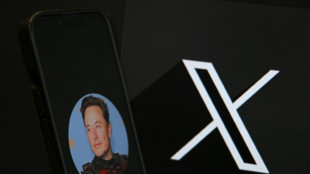
-
 US finalizes up to $6.6 bn funding for chip giant TSMC
US finalizes up to $6.6 bn funding for chip giant TSMC
-
Scholz urges Ukraine talks in first call with Putin since 2022


Moscow museum chronicles NATO 'cruelty' amid Ukraine campaign
Paintings of wounded children and grieving women line the walls, while loudspeakers spit out the sound of approaching war planes.
Welcome to a Moscow exhibition depicting NATO's "crimes" amid Russia's military campaign in Ukraine.
"NATO. A chronicle of cruelty" opened at the Museum of Contemporary Russian History in Moscow in early April, over a month after President Vladimir Putin sent troops to the pro-Western country.
According to the museum, the display is dedicated to the history of NATO including the United States' atomic bombings of Hiroshima and Nagasaki in 1945, despite the Western military alliance being founded only in 1949.
It also lists the bloc's bombing of Yugoslavia in 1999, US-led wars in Iraq and Afghanistan as well as cooperation between Ukraine and NATO "that has led" to the current conflict.
"Every time it's difficult to talk about the crimes committed by NATO troops," guide Yaroslav Polestrov, 46, said.
The Kremlin considers the US-led military bloc an existential threat to Russia and Putin blames Washington for using Ukraine as an instrument to draw Moscow into a conflict.
Since the start of Moscow's campaign in Ukraine, independent media outlets have been shut down or suspended operations while television channels have ratcheted up production of anti-Ukraine and anti-West propaganda.
Just days before Moscow's annual military parade to mark the Soviet victory in World War II on May 9, the exhibition is well attended.
At the entrance, a group of teenage cadets in uniform pose for a photo before heading inside, which, unusually in the Russian capital, is free of charge.
Lining the walls are photos of anti-NATO demonstrations in Europe and numerous photos of children in conflict zones, some visibly injured.
For the museum's senior researcher Fyodor Kokin, NATO has been playing a crucial role in the Ukraine conflict.
"We see that in fact the countries of the alliance are very actively involved in this conflict," Kokin, 28, said.
"They are supplying arms, equipment, and ammunition to Ukraine."
Part of the display is an "anti-tank missile launcher produced in the United Kingdom and used by the Ukrainian armed forces", Kokin said.
The exhibit was put together in "less than a few weeks" and has welcomed 14,000 visitors so far, he added.
One of those visitors, Alexandra, who declined to release her last name, said the display was a shoddy job.
"This was done in a hurry," said Alexandra, who teaches library science and brought her students to see the exhibition but now "regrets wasting time".
"Why are we talking about 'cruelty'? Why not talk about the reasons for the creation of the bloc, how it has evolved over time?" said the woman, sporting a black and orange ribbon pinned to her chest, a symbol of WWII victory celebrations in Russia.
Pointing to a section dedicated to the Vietnam War, Alexandra said, "It is the United States, not NATO," which is to blame.
- 'Soviet-style propaganda' -
Guide Polestrov shows Alexandra's students a jumble of Ukrainian blue and yellow flags displayed next to a Nazi SS helmet and a US flag, with maps illustrating just how far into Russia NATO missiles can reach.
On the 1999 NATO bombings of Yugoslavia, he said: "Russia and China did not agree with... the decision made by (Bill) Clinton, President of the United States and criminals like him".
Anyone disagreeing with the organisers' point of view is free to express their thoughts in the visitors' book, Polestrov said.
Some praised the display.
"It is necessary that children, adolescents and even many adults see for themselves how rotten the Western world is," two women, who signed their full names, wrote in a message seen by AFP.
Maria Butina, a lower house lawmaker who served 15 months in a US prison for illegally acting as a foreign agent for Russia, thanked the organisers for telling the "truth".
Other visitors blasted Moscow's narrative.
"This exhibition is Soviet-style propaganda crap," read one entry.
"There is no black and white in politics, there are only shades of grey," said another.
"Don't let the propaganda fool you. Peace to Ukraine and the whole world, freedom and wisdom to Russia!"
W.Morales--AT

